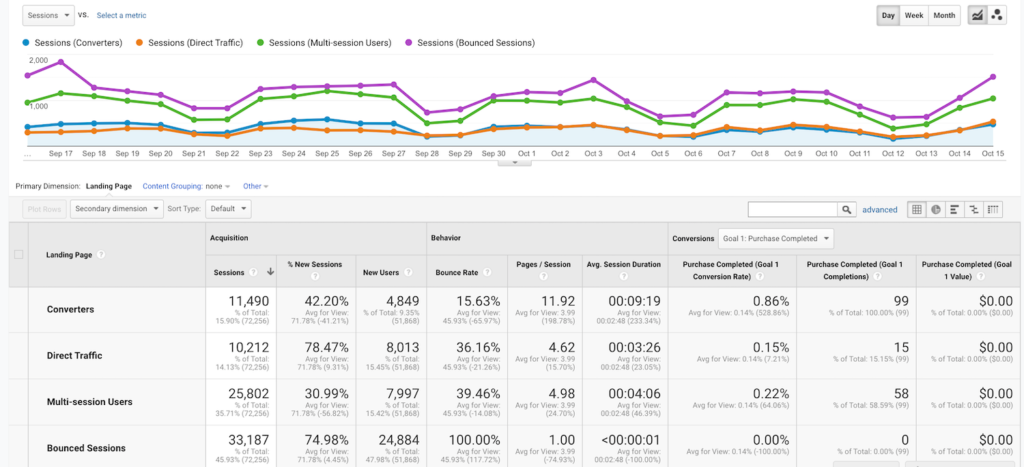What Data Is Google Analytics Goals Unable to Track: Vital Details
What Data Is Google Analytics Goals Unable to Track: Vital Details
Blog Article
Revealing the Blind Destinations: Comprehending What Google Analytics Goals Can not Gauge
In the world of digital analytics, Google Analytics stands as a powerful device for monitoring and analyzing online individual interactions. Recognizing what Google Analytics objectives can not gauge is crucial for acquiring a detailed view of customer behavior and involvement.
Customer Actions on External Operatings Systems
Recognizing just how users communicate on external systems is crucial for maximizing on-line approaches. External systems, such as social media networks, referral internet sites, and on the internet discussion forums, play a considerable function in driving website traffic to a company's web site. By evaluating customer behavior on these platforms, services can acquire important understandings into the performance of their advertising efforts and the choices of their target audience.
One trick facet of user actions on outside platforms is the referral source. By tracking where the users are originating from, services can recognize which platforms are driving the most traffic to their site. This information can aid business allocate their sources better, concentrating on the platforms that yield the ideal results.

Offline Conversions and Interactions
Evaluating user actions on outside systems offers important understandings right into online techniques; nevertheless, considering offline conversions and communications is equally vital for an extensive understanding of a company's overall efficiency. Offline conversions, such as in-store purchases or phone inquiries, play a considerable function in many companies' success.

Acknowledgment Beyond Last Click
When diving into the realm of electronic marketing analytics, it becomes necessary to look beyond the solitary touchpoint of the last click for a much more extensive understanding of attribution. While Google Analytics offers important insights into customer behavior, depending solely on last-click acknowledgment can be limiting - what data is google analytics goals unable to track. Attribution models that exceed the last click offer a much more nuanced sight of the customer journey, taking into consideration all the touchpoints that result in a conversion
Attribution past the last click permits online marketers to designate credit history to numerous interactions along the conversion course, offering a clearer picture of the effectiveness of various advertising and marketing channels. By exploring multi-touch acknowledgment models such as linear, time decay, Your Domain Name or position-based attribution, services can better assign their advertising budget plans and optimize their techniques for optimal influence.
Understanding the influence of each touchpoint in the conversion process is vital for making notified decisions and taking full advantage of Discover More ROI. By embracing acknowledgment beyond the last click, services can gain deeper insights into customer behavior and tailor their advertising efforts more successfully.
Cross-Device and Cross-Browser Monitoring

Likewise, cross-browser tracking matches cross-device monitoring by capturing individual behavior as they switch in between different web internet browsers. Comprehending how users communicate with web sites on numerous web browsers can aid marketing experts enhance their online experiences to guarantee consistency and performance across various platforms.
Qualitative Information and Customer Intent
Recognizing individual intent through qualitative data analysis is vital for establishing targeted electronic advertising and marketing strategies that reverberate with the demands and preferences of the target audience. Qualitative data provides insights into the 'why' behind user actions, dropping light on motivations, emotions, and preferences that quantitative information alone can not record. By analyzing customer feedback, comments, and communications, marketing experts can uncover beneficial info regarding individual intent, allowing them to tailor their messaging, web content, and offerings to much better line up with what their audience is looking for.
Qualitative data also helps in understanding the context in which users involve with a website or app. This contextual understanding allows marketers to develop even more personalized and pertinent experiences, inevitably driving greater engagement and conversion prices. By delving into individual intent through qualitative information analysis, companies can gain a much deeper understanding of their target audience, bring about a lot more effective advertising and marketing methods that fulfill individuals' assumptions and demands.
Conclusion
In conclusion, Google Analytics goals have limitations in gauging user habits on external systems, offline conversions, attribution past last click, cross-browser and cross-device monitoring, and my site qualitative information associated with customer intent. what data is google analytics goals unable to track. It is very important for companies to be knowledgeable about these dead spots in order to supplement their information evaluation with various other tools and methods to gain a much more detailed understanding of their audience and enhance their general digital advertising techniques
By evaluating user behavior on these systems, businesses can get beneficial understandings into the effectiveness of their advertising and marketing efforts and the choices of their target audience.
Analyzing individual habits on exterior systems provides beneficial insights into online approaches; nevertheless, taking into consideration offline conversions and communications is similarly crucial for a detailed understanding of a firm's general performance.In electronic advertising and marketing analytics, moving past last-click attribution to explore cross-device and cross-browser monitoring is essential for acquiring a holistic understanding of individual interactions across different systems and tools. By assessing user feedback, remarks, and communications, marketing experts can uncover beneficial information concerning user intent, enabling them to tailor their messaging, content, and offerings to better line up with what their audience is seeking.
By diving right into user intent with qualitative information evaluation, organizations can get a much deeper understanding of their target audience, leading to more effective advertising strategies that satisfy customers' assumptions and needs.
Report this page